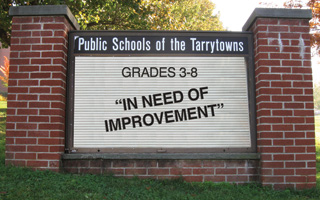 When the results of the 2011 round of No Child Left Behind – mandated testing for grades 3-8 are officially released later this year, the Union Free School District of the Tarrytowns expects to be labeled a District In Need of Improvement.
When the results of the 2011 round of No Child Left Behind – mandated testing for grades 3-8 are officially released later this year, the Union Free School District of the Tarrytowns expects to be labeled a District In Need of Improvement.
With word of this impending designation circulating among the villages, parents and community members have been galvanized into action, and are looking to the administration for answers and solutions. “We need to understand the issue much more deeply,” says Sleepy Hollow resident Jill Schurtz, who has three children in the school district. “We need to understand what’s underlying it, and most importantly, we need to understand what the plan is, to agree with the plan, and to work towards solving this problem.”
Part I: The Designation
This year will be the first year since the inception of the No Child Left Behind (NCLB) testing in 2003 in which our school district will not be deemed a District In Good Standing in accordance with the controversial Act. Each year, schools across the country must test all students in grades 3-8 in English Language Arts (ELA) and Math. A student is given a score of 1 through 4 based on the number of correct answers to the 45-60 question tests. The goal of NCLB is that by the year 2014, 100% of students will receive a grade of 3 or 4, and schools and districts will be held accountable if they fail to reach that bar. Each successive year, the percentage of students that must score a 3 or 4 rises as NCLB approaches its 2014 ultimatum, so a district must show improvement each year.
Districts are measured not just as a whole, but in individual subgroups, such as grade level, ethnicity, and economic status. If a single subgroup fails to hit its target, it counts against the school and district, even if the overall student body passed. Such is the case with the Public Schools of the Tarrytowns. The warning lights initially flashed last year. “A couple of our subgroups missed their targets [in 2010],” says Superintendent Howard Smith. “That was the first time. They were economically disadvantaged students, limited English proficiency students, and special education students.” Since it was the first time any subgroup had failed to hit their targets, the district remained a District In Good Standing in 2010. However, explains Dr. Smith, “If any one group one year and [that group or any other] group the next year falls short, then you are [deemed] in need of improvement.”
[inset side=left]However, explains Dr. Smith, “If any one group one year and [that group or any other] group the next year falls short, then you are [deemed] in need of improvement.”[/inset]
In 2011, the subgroups in Tarrytown that will have missed their targets for the second consecutive year are in the Middle School, which means only the Middle School will be labeled as a School In Need of Improvement. However, a number of other subgroups missed their targets for the first time in 2011, so if they fall short again in 2012, Washington Irving will likely join the Middle School with that designation next year. However, just having one school designated In Need of Improvement is enough to officially pin the label on the entire district.
Under NCLB, the consequence of being labeled a District In Need of Improvement is that the State will send in a “school quality review team” to take a look at the district, and the district must craft a two-year improvement plan on how they will work to raise student test scores. If the district remains In Need of Improvement in successive years, the State can begin to step in to take greater control. With the 2014 deadline, to have 100% of students pass the tests, only three years away, however, legislators in Albany and Washington are taking a hard look at what may be unrealistic expectations. According to an estimate by the New York State Department of Education, in 2010, 536 schools were designated In Need of Improvement in New York State. In 2011 that number climbed to 1,356, meaning 44% of public schools in New York State were In Need of Improvement. It is strongly speculated that number will increase again in 2012 when the bar to pass is raised yet again.
To the administration, the designation in and of itself is not driving their future plans. “Do we need to improve? We always need to improve. We know that there are some groups that struggle more than others and we need to always find ways to help them more. But to extrapolate that and put a label on and say the whole district needs to make some kind of a sea change in education in ways that basically converts it to an ELA and math boot camp [would be inappropriate],” says Dr. Smith, who points to the fact that even the subgroups that did not meet their targets showed improvement from the year before. “If we sincerely believed that it was the kind of problem that called for radical action, we’d be the first to say, ‘Let’s get radical here’… If our kids weren’t improving then we’d say, ‘Wait a minute, we have to blow this thing up because they’re treading water and they’re not getting it.’ But in fact, they are [improving]. This is a debate over how fast.”
Parents have expressed three main concerns about the impending designation. The first is the potential diversion of resources in the already-strapped school budget towards programs that may be needed to help lower-scoring students pass the tests. Second is a fear that in response to the pressure to hit their targets, the school district will “teach to the test” rather than offer a more well-rounded education. The third concern is in the stigma of the designation itself. Will it cause a loss in property values? Will it change how the villages of Tarrytown and Sleepy Hollow are perceived by those outside of the community? Will families who might otherwise move into the district shy away because of the designation?
[inset side=left]Some parents also feel the administration is not taking this issue seriously. The district knew the first subgroups initially failed as early as August of 2010, and parents are disappointed that this information was not brought to their attention. [/inset]
Some parents also feel the administration is not taking this issue seriously. The district knew the first subgroups initially failed as early as August of 2010, and parents are disappointed that this information was not brought to their attention. “I’ve been to pretty much every school board meeting since February; this has never been discussed,” says Sleepy Hollow resident Ken Torosian, who has one child currently in the district and two more who will be entering within a few years. The results of the 2010 NCLB testing were publically presented to the Board of Education at their November 2010 meeting, but since no announcements were made to the parents beforehand, the meeting was sparsely attended.
Torosian has a specific list of what he wants to see this time around from the administration and the Board of Education. “I want to know what was done, what was our assessment of what worked and what didn’t work, what are we changing to make it work better this time, and probably most importantly, I want to hear pretty much at every meeting how we’re doing and what’s happening,” he says.
As more and more parents discussed amongst themselves the results and the upcoming designation, Jill Schurtz decided to take the conversation out of the bus stop gossip phase and bring it out in the open. She invited a group of approximately 30 parents to her home in October to discuss the issue prior to November 3rd Board of Education meeting where the information would be publically presented for the first time. This was a chance for everyone to be heard, and was a productive way for concerned parents to channel their energy.
“The theme we heard continually at the meeting was that people feel strongly about this issue,” says Schurtz. “We really want the district to take the view that they should partner with parents on this issue, and that more than anything else they should be transparent about the approach. I don’t think people want to hear that the tests are wrong, we just want to hear what we’re going to do about it.” To this end, the group of parents agreed on three main messages to bring to the Board of Education Meeting on Nov 3:
- You are our Board, we need you to be our Board and serve the interests of our children and the community;
- We are here and we’re coming back until we have resolution; and
- We want to understand and participate in the Administration’s plan of action.
Part II: The Board of Education Meeting
Throughout the following week, the word was spread throughout the villages about the importance of the upcoming Board of Education meeting on November 3rd. The result was a crowd of over 100 at the meeting, which was moved from the administration building to John Paulding to accommodate the larger audience. At the meeting, these and other parents sat patiently as Dr. Smith, the administration, and the principals of WI, the Middle School and the High School went through a 115-minute presentation to the Board regarding the test scores and what the district plans on doing in response. The presentation, which is available for download from the district’s website, went through a statistical analysis of the data, compared the District’s growth to surrounding communities, Westchester County, and New York State, and documented what they plan on doing in response to the results.
After the presentation, the administration answered questions from the Board for another 45 minutes, and then it was the parents’ turn to speak. The tone of the comments was gracious yet determined. Many parents reiterated that they felt their children were getting an excellent education in the district, but that the test results showed that there was room for improvement. One area of focus was the concept of including more differentiated instruction in the curriculum (grouping students by NCLB test scores to better serve the needs of the individual students) and starting this tactic at an earlier age. Assistant Superintendent Barbarann Tantillo stated that some differentiated instruction was already in place at the Middle School and that they were developing an elementary model, but Dr. Smith cautioned against taking differentiation too far. “There is a strong body of research over years that shows that separating out lower kids and putting them all together with other kids who are low functioning does not achieve the desired result of helping them, because you rob them of every model of higher functioning,” se said.
A number of parents asked what was being done to help the students in the under-performing subgroups – specifically the economically disadvantaged students and the limited English-proficiency students (who are often the same students). Eventually, a much larger and more difficult issue arose. After Tarrytown resident and parent Gerardo Soto pointed out the lack of a Spanish translator at the meeting, fellow Tarrytown resident and parent Wanda Myers emphasized the need to reach out to the Hispanic community. “[Hispanic] parents are not going to come to these meetings because they do not understand English and they cannot not speak their minds, much less understand what’s going on. Instead of making everybody come here in an English-[speaking] setting, I was wondering, have you ever tried… [to hold meetings] in their own format to hear their voices and to hear their concerns and see how they can participate in finding a solution?” The Board agreed with a need to find ways to reach out to the Hispanic population of the district, and welcomed suggestions on how best to do so.
[inset side=left]“[Hispanic] parents are not going to come to these meetings because they do not understand English and they cannot not speak their minds, much less understand what’s going on.[/inset]
Some parents were skeptical that the administration’s proposals, while worthwhile over the long term, would do anything to solve the short-term problem of removing the unwanted designation as a District In Need of Improvement, a fear that Dr. Smith reinforced when he responded to Trustee Vincent Nadile’s question as to when he would say we would be rid of the designation. “I’ll be very candid. I would not predict that if the current regulations are unchanged, that we will get out of this designation, nor will any other school district that’s already been labeled… because it is more or less statistically impossible.” Others pointed out the inconsistency in blaming the test now that the district failed to pass it. Said one parent, “We cannot say this is a flawed test, and then say everything’s fine when we pass it.”
After many parents had spoken their minds, it became clear that there was a consensus within the audience for a desire to keep the broader public actively informed on what is being done to remove the designation from the district, and for the Board and administration to partner with the parents to find solutions to the problems facing the district. Board President Joseph Lillis assured everyone that the Board would, indeed, be reaching out to parents on this topic in the near future.
Dr. Smith admitted that he was a little unprepared for just how much this issue has ignited district parents. He acknowledged that he “got the message,” and that he fully appreciated their position, yet he cautioned against rushing into any far-reaching decisions. “We’re talking about driving an entire institution based on what happens on one spring morning when a group of kids sit down and take a 45 or 50 question test,” he says. “How much do you do so kids will get 3 or 4 more questions right on a test? How far do you go?”
[inset side=left]Dr. Smith admitted that he was a little unprepared for just how much this issue has ignited district parents.[/inset]
But Dr. Smith also reassured those present that he was taking this issue very seriously indeed. “I feel like there’s a sense that what you heard tonight doesn’t mirror the sense of urgency that you feel. All I can say is that I go to bed every night with a pit in my stomach and I wake up every day with a pit in my stomach,” he said. “What you heard tonight from the principals is not stuff that we will be doing, it’s stuff that we are doing. Now. Stuff that’s based on analyses we did during the summer in anticipation of some of these [results]. So, we’re retooling every year.”
Part III: Moving Forward
Dr. Smith has assured the public that he is open to all suggestions and has expressed a desire to form a partnership with district parents moving forward. The day after the meeting, he approached the group of concerned parents and asked them to put together a task force composed of parent volunteers as well as members of the administration that will study the issues brought to light by the NCLB testing, and look for creative ideas that can help the district shed its unwanted designation. The task force will meet regularly, creating sub-committees to execute recommendations for action that result.
In order to address the specific areas of improvement affecting the school district’s NCLB score, the EPTA of the Tarrytowns is announcing the formation of a dedicated group of volunteers who can offer help and support to the district’s students in need through already existing tutoring programs. The EPTA has begun reaching out to a number of the many excellent non-profit groups that work with the children of the community, with the objective of supplying additional volunteers to help augment their already valuable efforts. Volunteers will help with homework, read with the kids, and anything else that is needed. Anyone interested in volunteering can contact the EPTA at tarrytownepta@gmail.com.
About the writer…
David Neilsen is currently President of the EPTA, and the father of two children in the district.






